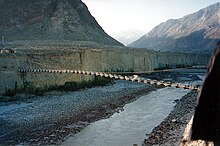Danyor Suspension Bridge
|
Danyor Suspension Bridge دیّورسو |
|
|---|---|
 |
|
| Coordinates | 35°55′10″N 74°23′20″E / 35.91944°N 74.38889°ECoordinates: 35°55′10″N 74°23′20″E / 35.91944°N 74.38889°E |
| Official name | Old Bridge Danyor |
| Other name(s) | Pul-e-Sirat |
| Preceded by | Traditional raft |
| Followed by | New Concrete Bridge |
| Characteristics | |
| Design | Medium |
| Material | Wooden span |
| Trough construction | Metallic ropes |
| Total length | 510ft |
| Width | 8ft |
| Towpaths | No |
| No. of spans | 1 |
| No. of lanes | 1 |
| History | |
| Contracted lead designer | Thekadar Birano |
| Engineering design by | Traditional Method |
| Rebuilt | No |
| Closed | Yes |
| Statistics | |
| Daily traffic | Allowed for 2-wheeled vehicles and pedestrians |
| Toll | No |
The Danyore Suspension Bridge is in Gilgit-Baltistan and is one of the oldest make shift suspension bridges in the region. The bridge connects Danyor to the premises of the Karakoram University across the River Hunza. Currently the bridge is closed for vehicles and only pedestrians and motorcyclists are allowed to pass through. Winds coming from northwest of the valley set the suspension brige to swing inducing minute resonances, it is therefore declared unsafe for normal traffic. There has been constructed a two way concrete bridge beside it, that is being used as an alternative which was completed in 2013.
Before the construction of the suspension bridge of Danyor there used to be a boat which is locally called Jaalo (a traditional raft for the passage crossing rivers and lakes) was used to cross the Hunza River. The bridge was constructed in mid-sixties. The Danyore side of the bridge is connected to a tunnel that was dug by the then residents of Danyore without any engineering tools and equipments almost a decade later.
...
Wikipedia
